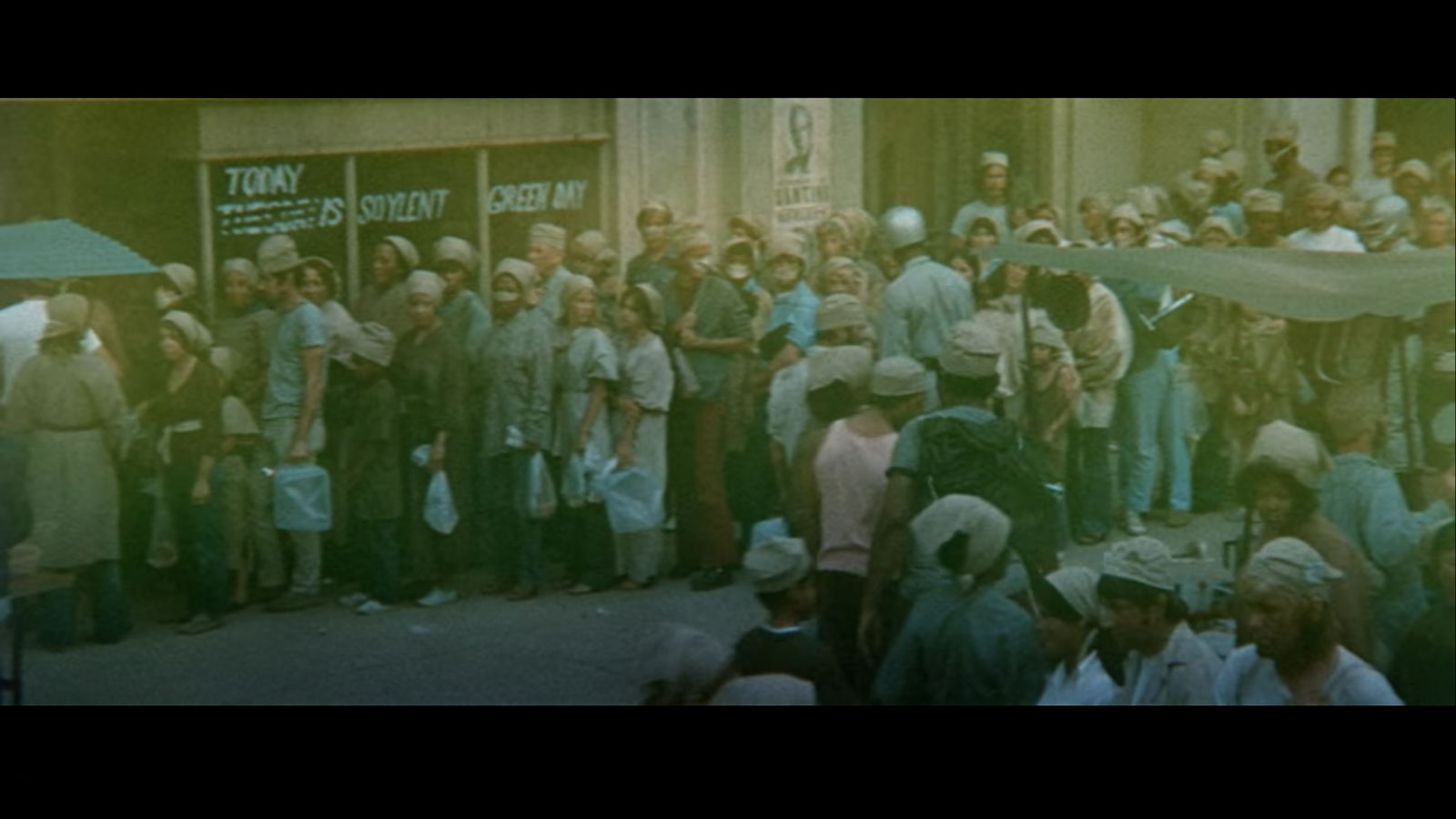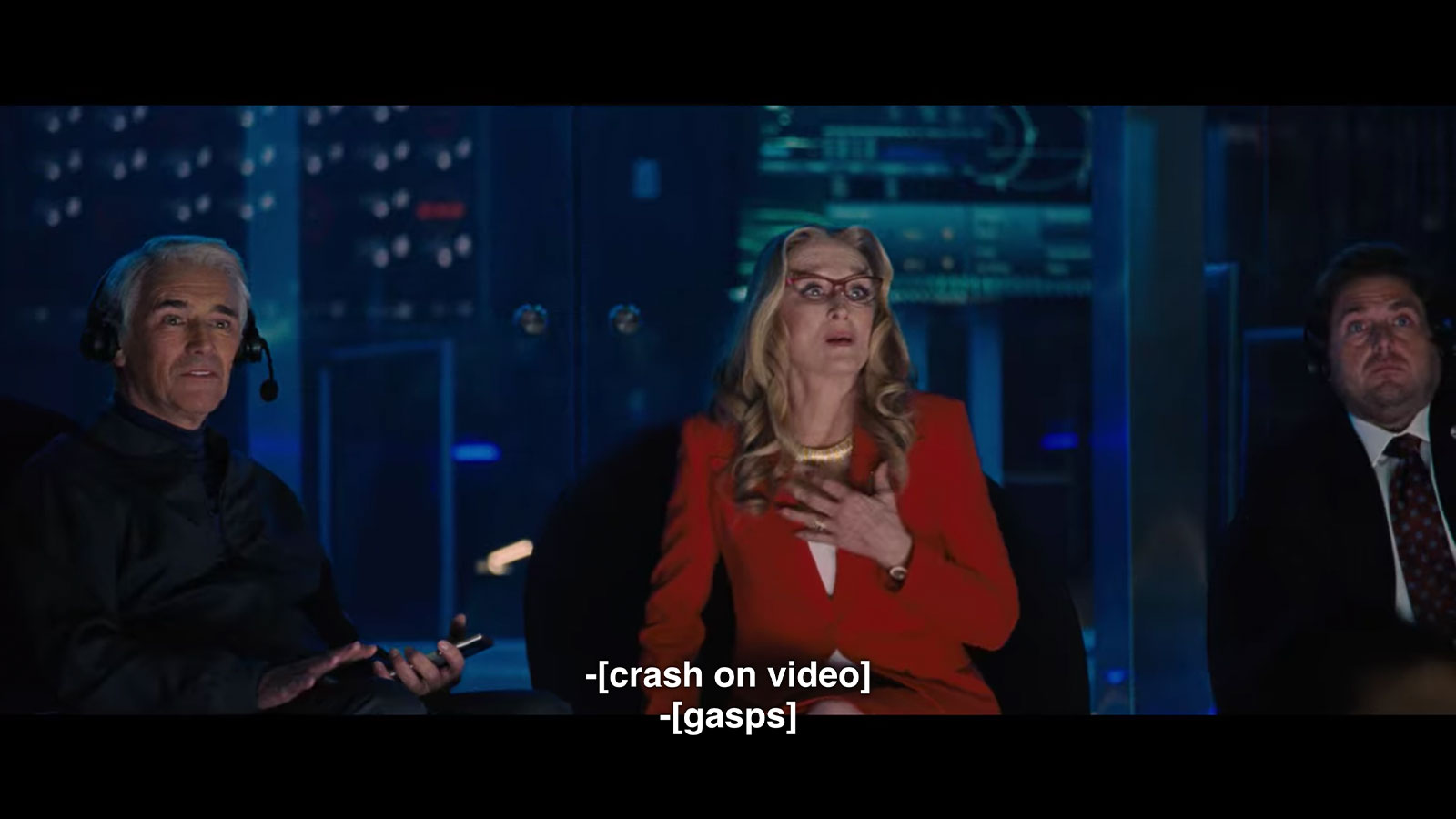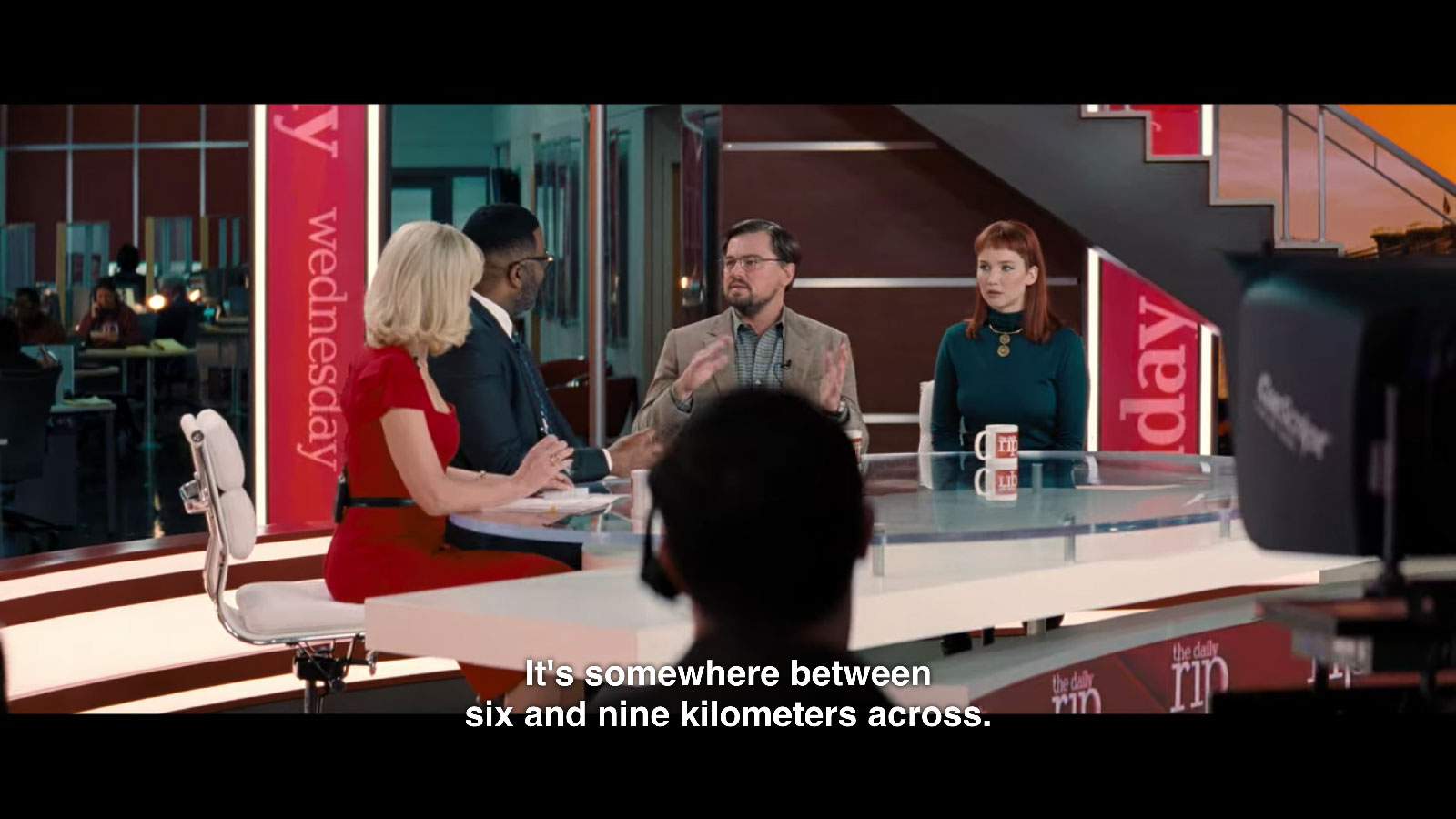In the year 2022, even the simple things in life have all but disappeared. A bar of soap is eyed with envy. Vegetables are a rarity, and strawberry jam goes for $150 a jar. People start weeping at the sight of raw beef.
This is the joyless vision of the future painted by Soylent Green, an eco-thriller from 1973 in which everyone’s face is coated with a layer of sweat. Not far into the film, it becomes clear that this perspiration is the result of climate change. “How can anyone survive in a climate like this?” one man complains. “A heat wave all year long.”
One of the first movies to use the phrase “greenhouse effect,” Soylent Green depicts a planet plagued by overpopulation, hunger, smog-choked skies, and dying oceans. Charlton Heston plays the grizzled Detective Thorn, who’s investigating a murder mystery while stepping around the many hungry people lying in the streets of New York City. Soylent Corporation has taken over most of the world’s food supply and hands out rations of the high-protein Soylent Green, supposedly made from plankton. New Yorkers are so dependent on Soylent Green that they riot when the supply runs out. Dump trucks are sent to deal with teeming crowds, scooping up handfuls of people with hydraulic shovels and tossing them in the back.
The real 2022, of course, didn’t quite turn out that way. (Yet.) But the dystopia portrayed in Soylent Green got a few predictions right, including a hotter planet, an acidifying ocean, and lots of people wearing cloth masks. It pictured the world population doubling to 7 billion, fairly close to today’s 7.87 billion — though this “population bomb” didn’t turn out to be the central problem the film made it out to be. And it was pretty prescient about the development of nutrient-stuffed food alternatives. Now you can buy real-life Soylent, a meal-replacement beverage that got its name from the 1966 sci-fi novel Make Room! Make Room!, in which nutritious “soy-lentil” steaks feed the masses. The movie is loosely based on this book, but (spoiler alert) in a plot twist, Soylent Green is made from human flesh, hence the famous line “Soylent Green is people.”

Half a century after this first entry into the canon of climate apocalypse movies, Hollywood has brought us another breakout success. In Don’t Look Up, a satirical film released on Netflix in late December, the United States government fails to take the threat of a planet-killing comet seriously, a heavy-handed allegory for global warming. It has quickly become the second-most-watched movie on Netflix ever. The popularity of Don’t Look Up can be partly explained by its star-studded cast, with Leonardo DiCaprio and Jennifer Lawrence as the truth-telling astronomers Randall Mindy and Kate Dibiasky, Meryl Streep playing a Trump-inspired U.S. president, and Ariana Grande a pop-star caricature of herself. When the two scientists embark on a media tour to talk about the comet they discovered, they watch in disbelief as their warnings get turned into infotainment. Morning show hosts treat the horrifying news as a feel-good science segment (“keep it light, fun!”), the government takes a wait-and-see approach to the impending disaster, and Big Tech plots to mine the comet for rare, expensive materials.
So what does one of the earliest popular climate disaster movies have in common with the latest one, 50 years later? On the surface, not much. Dystopian tales reflect the anxieties of their time, so it’s not surprising that the specter of overpopulation hangs over a film from the 1970s, whereas a movie from today mocks our smartphone-addled attention spans and misinformation-prone brains. But Soylent Green and Don’t Look Up share some surprising similarities — they paint a picture of a world controlled by greedy corporations and a population that’s become divorced from the real world, reflecting cynicism about the idea of “progress” and humanity’s ability to fix the problems we created. Comparing the two films offers a window into the illuminating ways people conceptualize planetary predicaments, then and now.
The natural world: See you never
When you see footage of innocent hummingbirds juxtaposed with giant piles of trash, it’s hard not to think, Jeez, humans are ruining everything! Both films make use of this technique at opportune moments, flashing through nature-documentary shots of wildlife — whales swimming, bees buzzing — alongside footage of smokestacks and dump trucks.
The images suggest that our disconnection from nature is part of the problem. In Soylent Green, people are banned from the countryside (walled fortresses keep out the masses), and even food has become unrecognizable green blocks. The only time people get to see what they’re missing is just before death: Those who elect euthanasia are treated to a movie of flowers, waterfalls, and deer right before getting turned into wafers of Soylent Green.
Don’t Look Up suggests that people’s disconnect with nature — and with reality in general — is the result of a distracted populace, too busy looking at screens, falling for misinformation, or obsessing over the latest celebrity breakup to look up at the extinction-threatening comet barreling toward them.
Neither film has much faith in humanity’s ability to solve environmental problems. “People were always rotten, but the world was beautiful,” Sol Roth, the aged college professor who aids Thorn’s quest, laments in Soylent Green. This dark view is reminiscent of the meme that became popular early on in the pandemic, when shutdowns induced by COVID-19 led to clearer skies and people hearing birdsong again: “Nature is healing. We are the virus.”
The villains
So, yes, humans can be crappy. But that doesn’t mean that the blame for the end times is equally distributed. In another long-standing environmental tradition, a hostility toward big corporations runs through both movies. Each casts a big corporation that benefits from everyone’s misery as a villain. Soylent Green investigates the murder of a wealthy board member of the Soylent Corporation who was reasonably troubled by the fact that he got rich off selling human flesh. The dystopian conditions favorable to Soylent Corp. are a natural confluence of greed, overpopulation, and climate change.

By contrast, in Don’t Look Up, the apocalypse is a single event and appears avoidable. The clearest villains are President Orlean and Peter Isherwell, the CEO of the Apple-ish BASH Cellular, the tech conglomerate overlord de jour. They eschew the reasonable plan of simply hitting the comet with nukes in favor of BASH’s idea of letting it get close enough to mine its resources. (BASH calculates that the comet contains $140 trillion in precious metals, which Orlean calls an “astonishing opportunity.) And when that plan fails, guess who gets to escape in a fancy spaceship? Yep, Orlean and Isherwell. It’s not unlike Soylent Green, where the rich live in penthouses with all the luxuries the masses have been denied, like running water and celery.
Scientists: Love them or hate them?
At one point in Soylent Green, Professor Roth remarks, “You know, when I was a kid, food was food. Before our scientific magicians poisoned the water, polluted the soil, decimated plant and animal life.” In other words, science and technology in the service of business messed everything up.
In Don’t Look Up, scientists are heroes and villains — academics are the good guys, corporate researchers are the baddies. Late in the film, Dr. Mindy makes an impassioned case for peer review, hoping to fix Isherwell’s doomed-to-fail plan hatched by a bunch of BASH scientists to extract resources from the comet. As the drones meant to mine the comet shoot up into the air, the triumphal music fades to klaxons when humanity’s last hope blows up spectacularly. The often-forgotten lesson here: Technology can be used to help people, or it can be used to maximize profits at the expense of everything else.
The truth hurts

In Soylent Green, the chief issue is that the truth (“Soylent Green is people!”) is being concealed. In Don’t Look Up, the truth is already out there, but it’s just too inconvenient to get worried about. On a media tour, Mindy and Dibiasky struggle to find the right words to tell television hosts that the world is ending. Yelling “We’re all 100 percent for sure going to f***ing die!” turns Dibiasky into a meme of ridicule. “Why aren’t people terrified?” Mindy asks afterward. “What do we have to say, what do we have to do?”
The environmental movement has long held the notion that if people just knew what was happening, they would be empowered to take action. More and better information would fix the problem. But it turns out that behavior is a lot more complicated than that, especially when it comes to our overheating planet.
In the end, a world-ending comet isn’t the perfect metaphor. Unlike a comet, as Eric Levitz wrote for the Intelligencer, climate change doesn’t have a do-or-die deadline, and the technology doesn’t exist to address the predicament without disrupting the status quo. If only solving climate change was as easy as aiming nukes at a comet and blowing it to smithereens.
This story was originally published by Grist with the headline ‘Don’t Look Up’ and ‘Soylent Green’: Hollywood keeps telling similar stories about the end of the world on Jan 18, 2022.
